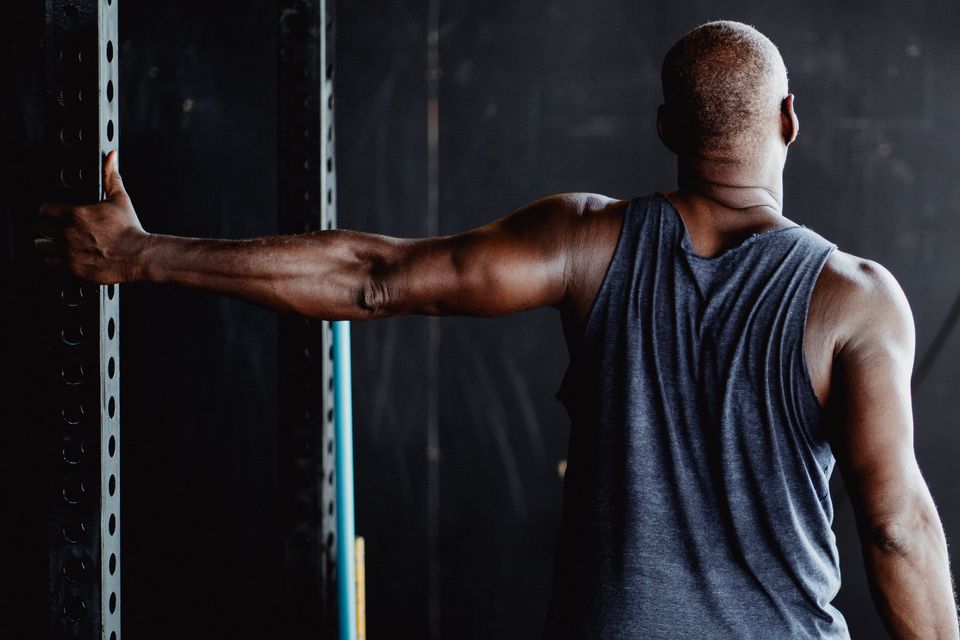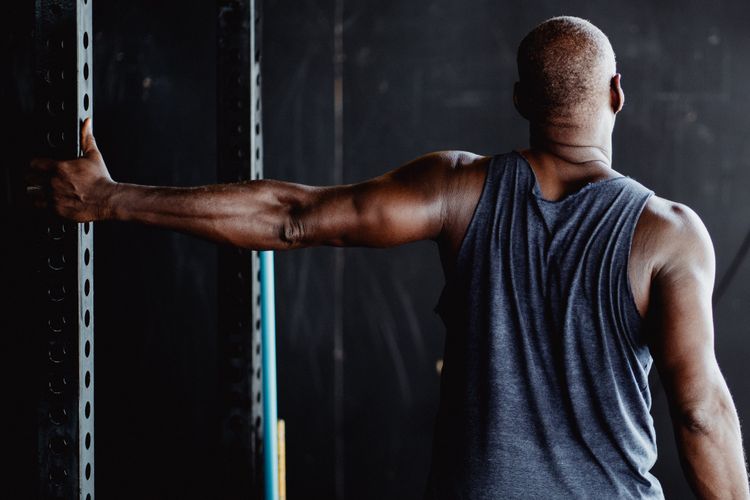PT Crab 🦀 Issue 164 - Best of Shoulder

This week, I’m bringing you 5 different articles, because I couldn’t come up with just 4. They’re about the shoulder and point out that I haven’t covered the shoulder as much as I maybe should. So watch out for some soon. For today though, we’re looking into whether or not you can estimate shoulder positions without a Goni, details on treating biceps tendinopathy (which I just re-read since I have a patient with that), how to change shoulder muscle activation by changing postures, and then two shoulder performance tests, the Unilateral Seated Shot-put and the CKCUEST.
Here’s the survey link again. It’s like 5 questions and I really appreciate everyone who has already done it. Please join them in helping me make a better Crab here.
Enjoy the cold and do stay warm.
See you next week,
Luke
Just Get A Goni
The Gist - Look, you can’t estimate shoulder posture just by looking at it. I know you think you can, but these guys proved that you can’t. These researchers grabbed a bunch of PT students and showed them 30 images of a bunch of different shoulder postures, then asked them to estimate abduction, flexion, ER, IR, or extension values. They missed, badly. All flexion, extension, and IR/ER estimates were significantly different from measured values, while they only significantly missed on abduction when the value was greater than 90°. They missed flexion by an average of 11°, extension by an average of 8°, IR by about 11° and ER by around 10°. Not good. And I know, I know, you’re not a PT student so you can do a lot better. And maybe you can, but if you’ve been estimating postures for years, maybe reconsider your process, use a goni for a few weeks, and reset your perspective.
Tell Me More - Previous literature cited by the study has shown that PTs are bad at estimating knee, ankle, and neck motion as well, so this miss is nothing new. A different study also showed that experienced PTs could estimate one particular shoulder flexion posture within about 3°, so that’s good, but we don’t have enough data yet to see if that holds for anything else. Reliability between examiners for that study was just fair, and other data has shown that healthy shoulders (the type used in this study and most of these studies) are easier to assess than pathologic ones. In one study, the standard error of measurement of a pathological shoulder was 13.8°. Does it feel like I’m working really hard to convince you not to estimate when you need an actual value? Good. Because this study and others have shown that you probably can’t do it. So stop doing it.
I want to read this shit. Feel free. They have as little faith in your estimation abilities as I do.
Experts on Biceps Tendinopathy
The Gist - This Delphi study from the International Journal of Sports Physical Therapy asked 29 international experts in PT how much or little they agreed with methods of treatment for biceps tendinopathy. Via a three-round survey system, the experts evaluated dozens of statements related to tendinopathy treatment. The statements were then ranked on level of agreement and organized in order of most consensus to least. Overall, tendon loading techniques using concentric and eccentric loading via both elbow and shoulder flexion achieved 100% agreement as did progressive resistance exercises for biceps and serrates anterior. Open and closed-chain work of the scapular stabilizers and rotator cuff also received 100% or near-100% agreement from the 29 experts.
We’ll get into more of what they agreed upon positively below, but more interesting to me was what they disagreed upon and what they agreed upon negatively. There was no consensus on the effectiveness of IASTM, deep transverse friction massage of the biceps or biceps tendon, or thrust manipulation of the GH joint. Consensus disagreement was largely limited to biophysical agents with iontophoresis, phonophoresis, IFC, NMES, TENS, ultrasound, and low level laser therapy receiving fewer than 6 of the 29 votes each.
Tell Me More - Other large areas of agreement were non-thrust manipulation of the GH joint, thoracic spine, cervical spine, ST joint, and AC joint. Thrust manipulation of the thoracic spine and CT junction received significant agreement as well. For the last general statement we’ll talk flexibility, where pecs major and minor, upper traps, lats, and rotator cuff muscles were generally agreed upon. Biceps flexibility received consensus agreement though it was more weakly agreed upon than the stretching of any other muscles included.
What’s the point? Unlike other methods, Delphi studies directly investigate what experts do in clinical practice. There were significant areas of disagreement and agreement to guide your practice and provide multimodal interventions to your patients. In that way, it’s quite useful. In other ways, it’s not. This work isn’t nearly as specific as the prior one on Achilles tendons, nor does it have significant specific evidence behind the interventions. Still, if you’re looking for ideas and a path forward with a challenging patient, it can be a good guide.
Paper? Right here.
For More Upper Trap Activation, Bend Your Knee. Wait, What?!
The Gist - This surprising research study from the Journal of Athletic Training shows how small positional tweaks can change scapular muscle activation in really interesting ways. The researchers had their subjects perform bilateral shoulder elevation with external rotation (bent elbows and lifting arms in front of face to above head by flexing shoulders while maintaining tension on theraband between hands) in five different positions and measured EMG activity in Serratus Anterior, Upper Traps, Middle Traps, and Lower Traps to compare. Details of the positions are in the next section, but the gist is this: small tweaks in body position made changes in muscular activity. Perhaps the most surprising is in the title. Doing the same shoulder elevation exercise during dynamic unipedal squat increased Upper Trap activity by 5% and decreased Lower Trap by 5%. Interesting stuff.
Tell Me More - Here are those positions you asked for:
- Open hands
- Closed hands
- Dynamic bipedal squat
- Static unipedal squat
- Dynamic unipedal squat
They weren’t in full pistol squat (as I thought at first) rather they flexed their knees to about 30°. Every exercise produced some differences, but the largest were in the lower limb category. It changed the balance between parts of the Traps, emphasizing upper over lower. Closing the hands decreased Middle Trap activation by 3.5% and Lower by almost 8% as well. These little tweaks make pretty big differences to the balance.
What else? Well, they used 31 healthy participants aged about 23 on average, they weren’t the first to show difference like this, and there are some limitations. The biggest is that we don’t yet know what difference this activation makes to the muscles, since they only did it one. Does it change scapular dysfunction rehab? No idea. That needs to be investigated. Should you use it? Maybe. If you want to tweak which part of the Traps get used, this is a super easy way to do it.
Lastly, did you not understand how I explained the exercise? Yea, me either. It’s hard to describe, okay? There are great images and descriptions in the paper.
Since you let me down by poorly describing this, can I read the paper then? Sure, but you don’t have to be so mean about it. It’s here and Open Access because the JAT is awesome.
Unilateral Seated Shot-put
The Gist - In this test, you’re going to have to sit in a chair. An armless chair, to be fair. And you’re going to put your feet up on another chair so you’re in long sitting. Then you’re going to strap yourself to the chair. And unless you’re really flexible, I recommend you have someone else strap you in. Hang on tight. And again, as general idea, this test can be used to measure readiness for sport activity such as golf, tennis, pickleball, basketball, volleyball, and racquetball, but it can also be used as an easy to perform direct comparison between arms as a general assessment.
After you’re strapped in, you’re going to throw a 6lb/3kg medicine ball with one hand. It’s recommended that you warm up a bit first to dial in the technique so you’ll be throwing with a shot-put motion (and I like to put the chair against a wall to ensure this happens) with one throw at 25% of max, one at 50%, one at 75% and a final one that you feel is at 100%. Then you’ll repeat this on the other side and then you’ll take a two minute rest. Afterward, you’ll do the real test. Three maximal efforts with each arm with a 20-30 second rest between throws. If all distances are within about 10%, you’re done. Take the distance of the longest throw from the front of the chair.
Stats?Stats I have. But not a ton really. We know a lot about between-arm comparisons with healthy people and expect that the dominant arm is between 100% and 110% of the non-dominant. Less than 100% indicates weakness of the dominant arm and more than 110% indicates weakness of the non-dominant.
The minimum detectable change on this one in healthy recreationally active adults (Tegner score of about 4) is 17 inches with the dominant arm and 18 with the non-dominant. But let’s just call it 18 between us. The SRA Lab page has some norms on different ages and genders ranging through men and women from ages 18-42. Enbies appear to be out of luck, as usual. The test has excellent test-retest and interrupter reliability and can be done with lighter medicine balls if you just want to compare arm to arm for weaker individuals.
Paper? I mean, sure. Here’s what I have:
- The Seated Medicine Ball Throw as a Test of Upper Body Power in Older Adults
- Reliability, Minimal Detectable Change, and Normative Values for Tests of Upper Extremity Function and Power
CKCUEST OMG
The Gist - We’re here to talk about the Closed Kinetic Chain Upper Extremity Stability Test, AKA the CKCUEST which is not a good name but at least it does what it says on the tin. In this test, you have the patient assume a high plank position with their hands 36 inches (91cm) apart on two pieces of tape or other type of marker. Their feet should be less than shoulder-width apart. Then you give them 15 seconds to touch each hand to the opposite piece of tape as fast as possible without losing their balance. And you count the touches. It’s hard to explain, I know. So check it out here: https://www.youtube.com/watch?v=UDvJSLfwS5c
Why do you do this? The test was designed for what it says on the box, to test CKC UE stability. And it does a pretty good job of it. This 2015 paper from BMC MSK Disorders attests that it’s reliable in both sedentary and active populations and that the MDC is somewhere between 2 and 4. They believe that “at least three touches are needed to be considered a real improvement on CKCUES Test scores.”
For women, this test can be performed in the modified pushup position from knees. Fun fact! In a standard pushup position, you take about 75% of body weight on your hands. In a modified position, it’s 60%.
Tell Me More - According to the Shirley Ryan Ability Lab (which is amazing if you don’t already know about it), for active males in their 20s, the mean number of touches was about 19 and it was 20 for active women (in the modified position). For women with subacromial impingement and a mean age of about 50, the average number of touches was 6 and for similar men, the number was 7.5. The MDC remains about three through all of these populations.
Test-retest reliability is excellent throughout. And it’s not part of the test, but in my experience it’s nice to give the patient a few practice touches to start before taking a short break and then attempting the real test.
Paper? That’s not really how this edition works, but I’ll point you to a paper or two.
- Test-retest reliability of the closed kinetic chain upper extremity stability test (CKCUEST) in adolescents
- Closed Kinetic Chain Upper Extremity Stability test (CKCUES test): a reliability study in persons with and without shoulder impingement syndrome
Thanks for sticking around to the end. Here’s another link to that survey. Please help! It does make a difference. Bye!





Comments
Want to leave a comment and discuss this with your fellow PTs? Join PT Crab and get summarized PT research in your inbox, every week.